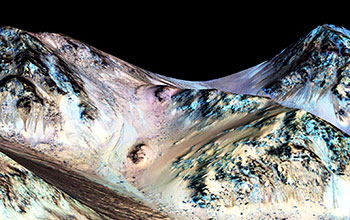Multimedia Gallery
Streaks, believed to be flowing water, on Mars
A false-color image of streaks, believed to be flowing water, on Mars at Hale Crater.
More about this image
A new study led by scientists at the Georgia Institute of Technology and funded in part by the National Science Foundation (NSF) Graduate Research Fellowship program (grant DGE 11-48903) provides the strongest evidence yet that there is intermittent flowing liquid water on present-day Mars.
Researchers used instruments onboard NASA's Mars Reconnaissance Orbiter to measure spectral signatures of hydrated minerals on slopes where mysterious, possibly water-related streaks are found on the red planet. The streaks, known as recurring slope lineae, form and snake down the planet's steep slopes during warm seasons, when temperatures exceed -10 degrees Fahrenheit (-23 degrees Celsius), and disappear at colder times during the Martian year.
To learn more, see the NSF News From the Field story Mineralogical evidence confirms liquid water on Mars. (Date image taken: 2015; date originally posted to NSF Multimedia Gallery: Nov. 24, 2015)
Credit: NASA/JPL/University of Arizona
Images and other media in the National Science Foundation Multimedia Gallery are available for use in print and electronic material by NSF employees, members of the media, university staff, teachers and the general public. All media in the gallery are intended for personal, educational and nonprofit/non-commercial use only.
Images credited to the National Science Foundation, a federal agency, are in the public domain. The images were created by employees of the United States Government as part of their official duties or prepared by contractors as "works for hire" for NSF. You may freely use NSF-credited images and, at your discretion, credit NSF with a "Courtesy: National Science Foundation" notation.
Additional information about general usage can be found in Conditions.
Also Available:
Download the high-resolution JPG version of the image. (2.4 MB)
Use your mouse to right-click (Mac users may need to Ctrl-click) the link above and choose the option that will save the file or target to your computer.



